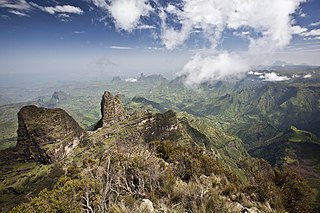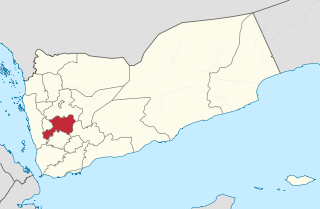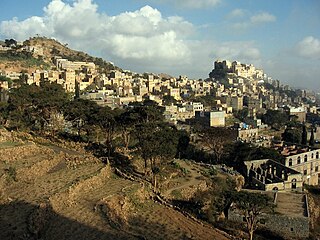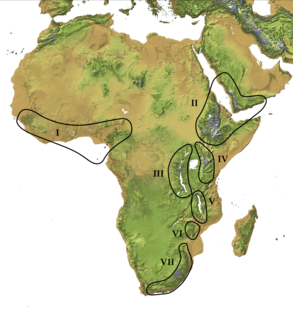
The Highlands is a historic region of Scotland. Culturally, the Highlands and the Lowlands diverged from the later Middle Ages into the modern period, when Lowland Scots replaced Scottish Gaelic throughout most of the Lowlands. The term is also used for the area north and west of the Highland Boundary Fault, although the exact boundaries are not clearly defined, particularly to the east. The Great Glen divides the Grampian Mountains to the southeast from the Northwest Highlands. The Scottish Gaelic name of A' Ghàidhealtachd literally means "the place of the Gaels" and traditionally, from a Gaelic-speaking point of view, includes both the Western Isles and the Highlands.

Yemen is located in Southwest Asia, at the southern tip of the Arabian Peninsula, between Oman and Saudi Arabia. It is situated at the entrance to the Bab-el-Mandeb Strait, which links the Red Sea to the Indian Ocean and is one of the most active and strategic shipping lanes in the world. Yemen has an area of 527,970 square kilometres (203,850 sq mi), including the islands of Perim at the southern end of the Red Sea and Socotra at the entrance to the Gulf of Aden. Yemen's land boundaries total 1,746 kilometres (1,085 mi). Yemen borders Saudi Arabia to the north and Oman to the northeast.

The Arabian peninsula, simplified Arabia, is a peninsula of Western Asia situated northeast of Africa on the Arabian plate. From a geographical perspective, it is considered a subcontinent of Asia.

The Great Dividing Range, or the Eastern Highlands, is Australia's most substantial mountain range and the third longest land-based range in the world. It stretches more than 3,500 kilometres (2,175 mi) from Dauan Island off the northeastern tip of Queensland, running the entire length of the eastern coastline through New South Wales, then into Victoria and turning west, before finally fading into the central plain at the Grampians in western Victoria. The width of the range varies from about 160 km (100 mi) to over 300 km (190 mi). The Greater Blue Mountains Area, Gondwana Rainforests, and Wet Tropics of Queensland World Heritage Areas are located in the range.
Highlands or uplands are any mountainous region or elevated mountainous plateau. Generally speaking, upland refers to ranges of hills, typically up to 500–600 m. Highland is usually reserved for ranges of low mountains.

The Ethiopian Highlands is a rugged mass of mountains in Ethiopia, situated in the Horn region in northeast Africa. It forms the largest continuous area of its elevation in the continent, with little of its surface falling below 1,500 m (4,900 ft), while the summits reach heights of up to 4,550 m (14,930 ft). It is sometimes called the Roof of Africa due to its height and large area. Most of the Ethiopian Highlands are part of central and northern Ethiopia, and its northernmost portion reaches into Eritrea.

Dhamar, also spelt Thamar, is a governorate of Yemen. It is located to the south and southeast of Sana'a Governorate, to the north of Ibb Governorate, to the east of Al Hudaydah Governorate and to the northwest of Al Bayda' Governorate in the central highlands of Yemen. It has a total areas of 7,586 km2 (2,929 sq mi) and an estimated population of around one and a half million.
The visitor enters Dhamar governorate about 70 km south of the Sana’a airport. The center of the governorate is about 100 km (62 mi) from Sana’a, the capital of the Republic. The governorate sits among a number of other governorates: Sana’a to the north and northeast, al-Bayda’ to the east, Ibb to the south, and Raymah and al-Hudaydah to the west.

Al Mahwit is the capital city of Al Mahwit Governorate, Yemen. It is located at an elevation of about 2000 metres.

Tihamah or Tihama refers to the Red Sea coastal plain of the Arabian Peninsula from the Gulf of Aqaba to the Bab el Mandeb.

The Afromontane regions are subregions of the Afrotropical realm, one of the Earth's eight biogeographic realms, covering the plant and animal species found in the mountains of Africa and the southern Arabian Peninsula. The Afromontane regions of Africa are discontinuous, separated from each other by lower-lying areas, and are sometimes referred to as the Afromontane archipelago, as their distribution is analogous to a series of sky islands.
The culture of Yemen has an ancient history, influenced by Islam. Due to its unique geographic location, Yemen has acquired a very distinctive culture from its neighbors; historically and culturally.
The Saudi–Yemeni War was a war between Saudi Arabia and Yemen in 1934.

The Sarawat Mountains, also known as the Sarat, is a mountain range in the western part of the Arabian Peninsula. In a broad sense, it runs parallel to the eastern coast of the Red Sea, and thus encompasses the Asir and Hijaz Mountains, which can be seen as including the Midian Mountains. In a narrow sense, the Sarawat start in Asir in southern Saudi Arabia, and extend to the Gulf of Aden in the south, running along the entire western coast of Yemen, in what used to be North Yemen, and extend eastwards into part of what used to be South Yemen, thus running parallel to the Gulf of Aden.

The Asir Mountains is a mountainous region in southwestern Saudi Arabia running parallel to the Red Sea. It comprises areas in the 'Asir Region of Saudi Arabia, however it also generally includes areas near the Yemeni border. The mountains cover approximately 100,000 square kilometres (40,000 sq mi) and consists of mountains, plains, and valleys of the Arabian highlands. Sensu lato, they are part of the Sarawat Mountains, defining the latter as the mountain range which runs parallel to the Tihamah throughout the western portion of the Arabian Peninsula, particularly the western parts of Saudi Arabia and Yemen.
Qishr is a Yemeni traditional hot drink made of spiced coffee husks, ginger, and sometimes cinnamon. In Yemen, it is usually drunk instead of coffee because it doesn't need to be roasted.
Riḍwān ibn Muṣṭafā ibn ʿAbd al-Muʿīn Pasha was a 16th-century Ottoman statesman. He served terms as governor of Gaza in the early 1560s and in 1570–1573, Yemen in 1564/65–1567, Habesh and Jeddah in 1573–1574 and Anatolia in 1582/83 until his death. During his term in Yemen, Ottoman authority largely collapsed. Ridwan Pasha was the progenitor of the Ridwan dynasty, which chose Gaza as its family headquarters, and where members of the dynasty ruled almost consecutively until 1690.
The wildlife of Yemen is substantial and varied. Yemen is a large country in the southern half of the Arabian Peninsula with several geographic regions, each with a diversity of plants and animals adapted to their own particular habitats. As well as high mountains and deserts, there is a coastal plain and long coastline. The country has links with Europe and Asia, and the continent of Africa is close at hand. The flora and fauna have influences from all these regions and the country also serves as a staging post for migratory birds.
The Yemen monitor is a species of Varanus that lives in Yemen and the South West of Saudi Arabia. It was dicovered in 1985 in TV documentary.













